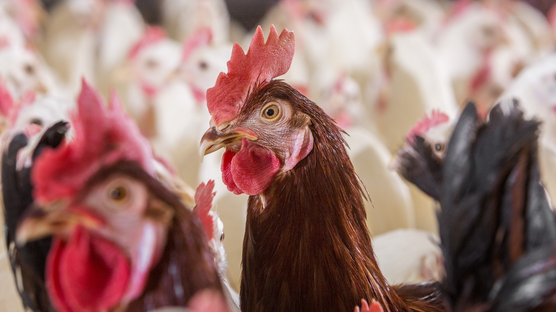
Published on May 1, 2019
Monitor Your Pullets
Getting your pullets to the correct weight by the end of rearing is fundamental in achieving good peak production, better persistency and better shell quality. Monitoring and keeping records of your pullets is so essential to successfully achieving the right bodyweight.
Getting your pullets to the correct weight by the end of rearing is fundamental in achieving good peak production, better persistency and better shell quality. Monitoring and keeping records of your pullets is so essential to successfully achieving the right bodyweight.
Keeping track of the birds’ records is a good management practice that allows the identification and solution of problems. Keeping track of records allows you to compare it to the advised standards and to your previous flocks. When you have identified a problem, such as your birds are not developing according to your expectations, you might be able to fix it in time. Identifying the cause and solution of an issue is an important part of the farmer’s knowledge base and is likely to assist in preventing a recurrence of the problem. Next to your record-keeping sheets on mortality, growth and feed/water intake, an extremely useful tool is a diary where you could note down any occurrence of disease, repairs, vaccinations, treatments and response to treatments.
Monitor Growth
Development of the digestive tract, the immune system and the bird’s frame is rapid in the first 8 weeks of life. The bodyweight at 5/6 weeks of age is the most important determinant of pullet quality. Disease, poor nutrition or other stressors at this stage can have a permanent negative effect on the bird’s ability to digest and absorb nutrients. Likewise, there may be a long-term impact on the immune system, making it more susceptible to disease. Bone calcification accelerates in the first few weeks of life and continues beyond the start of lay. Any deficiency in growth or skeletal development may limit the potential calcium reservoir needed for egg shell strength later in the hens’ productive life.
The best advice is to weigh your birds weekly from the moment that the day-old chicks arrive at your barn. The objective is to have a vey high uniformity in order to facilitate flock management and stimulation. The weight distribution across the flock is an indicator of good management. In an ideal world, more than 90% of the flock should fall within the 10% of the targeted bodyweight for that specific age. Large variations can be caused by the feed regime, overcrowding and disease. The number of feeders and drinkers, feed distributions, next to the feed presentation are strong contributors to ensure uniformity. Under warm environmental conditions we recommend the equipment requirements mentioned in table 1.
| Floor | Floor | Cages | Cages | ||
|---|---|---|---|---|---|
| 0 - 2 Weeks | 2 - 5 Weeks | 0 - 3 Weeks | 3 - 5 Weeks | ||
| Ventilation | Minimum ventilation rate | 0.7 m³/hour/kg | 0.7 m³/hour/kg | 0.7 m³/hour/kg | 0.7 m³/hour/kg |
| Required ventilation capacity | 4 m³/hour/kg | 4 m³/hour/kg | 4 m³/hour/kg | 4 m³/hour/kg | |
| Stocking densities | Birds/m2 | 30 | 20 | 80 | 45 |
| cm²/ bird | 125 | 220 | |||
| Water supply | Chicks/ Chick drinker | 75 | 80 (1) | ||
| Birds / drinker | 75 | 75 | |||
| Birds/nipple | 10 | 10 | 10 (2) | 10 (2) | |
| Feed supply | Birds / Starting pan | 50 | (3) | ||
| cm of trough feeders (4) | 4 | 4 | 2 | 4 | |
| Birds / Round feeder | 35 | 35 |
(1): Place one additional drinker per cage for the first week
(2): Make sure that all the birds have access to at least 2 nipples
(3): Spread sheets of paper over the cage bottom to last for 7 days, remove the top sheet every day
(4): when chain feeders are used, both sides of the through should be taken into account if both sides are accessible
Monitor Health
In all production systems, signs of disease can be detected when the birds reduce their feed and water intake, stagnate in their growth, or when they undergo a change in appearance, in their behavior or activity level. A key indicator of the birds’ health is monitoring the flocks’ mortality, but unfortunately, a dead bird is often a sign that you have been too late. If you can monitor and keep track of the earlier mentioned traits accurately you might be able to take actions that will prevent birds from dying. Monitoring and keeping track of the daily mortality can warn you if things are going terribly wrong and can be used to alert you or your veterinarian in case of infectious diseases.
Both farmers and their staff play a critical role in looking after the birds and maximizing productivity and therefore profitability. As a large part of taking care of poultry is about routine checks on the birds and their environment, it is important to train yourself and your staff in monitoring the birds carefully and to register the records and any deviations daily. This will allow you to get a better grip on your flock and to quickly identify quickly any changes in the flock and in the birds’ environment, such as broken equipment, moldy feed or infectious diseases. To conclude, accurate administration of the day to day records will help you in steering your flock and to interfere timely when needed, resulting in strong and robust pullets.



